To say “remote work has become more common” would be the understatement of the last decade.
Remote worker. Digital nomad. Telecommuter. Whatever you want to call it, millions of people are ditching the office for the freedom and flexibility to work wherever they choose.
Normal offices aren’t dead. But they’re clearly starting to age.
In fact, 7 out of 10 people work remotely at least once per week, and our data tells us that number will keep growing.
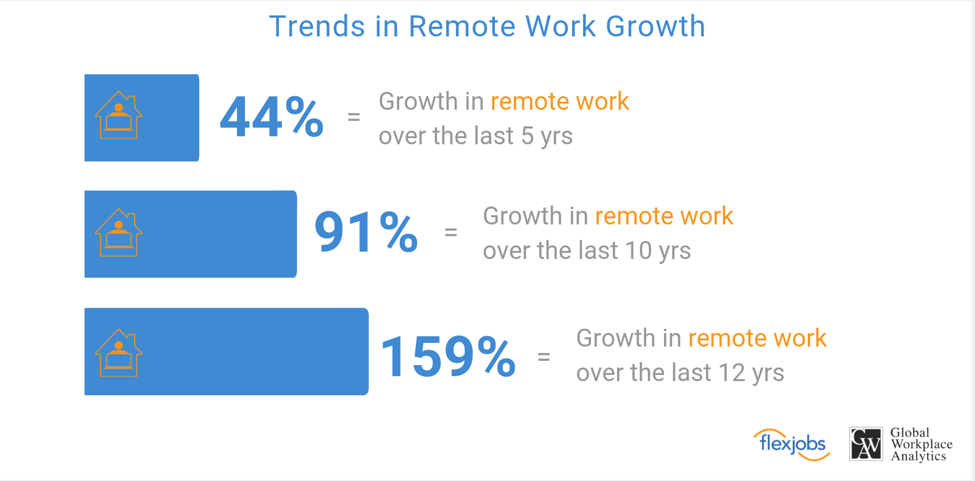
Just go to any office on a Friday afternoon (or morning) these days, and you just might be the only one there.
What does this mean for you, the manager of a remote team?
Maybe you’re based in your company’s LA headquarters and most of your team works out of offices in Austin. Or maybe you’re in Atlanta and manage a group of developers in Philly or a field marketing team in New York City.
- How do you manage workers in different locations and time zones?
- What steps do you take to build trust and accountability?
- How should you establish work processes?
This guide covers how to create a positive team environment and make sure your remote team feels connected to other colleagues.
Whether your team members are in distant countries or you have local people who would rather work from home, the same rules apply.
This post covers seven tips for managing your remote team more effectively:
How to use these tips:
- This post covers a lot of ground, and you probably won’t be able to implement every single tactic at once. That’s why we recommend you refer back to it as a refresher as you go through your remote team management journey.
Set Clear, Specific Expectations
Tag: Communication
Difficulty: Easy
When you tell someone face to face, “I need this done quickly,” they can read your body language (tense expression, quick pacing) and your tone (anxious, rushed) that “quickly” means asap.
But if you email someone, “I need this done quickly,” it can mean different due dates to each person. Some might think you mean “end of the week” or maybe “in a few days.”
A good idea is to send each member of your team a creative brief and have them fill out each section to define their role within the project.
Here’s a great template from CoSchedule:

Remote workers tend to be less willing to ask questions than in-person. And they won’t be able to tell what you mean by your body language or tone of voice. Having templates adds structure to the job that keeps both sides closer to being on the same page.
For those reasons, be clear and specific with your expectations when using email or chat apps (e.g. Slack).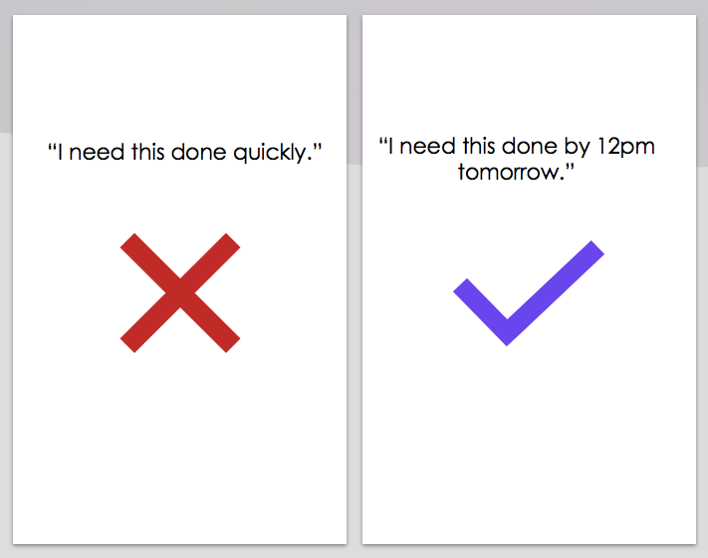
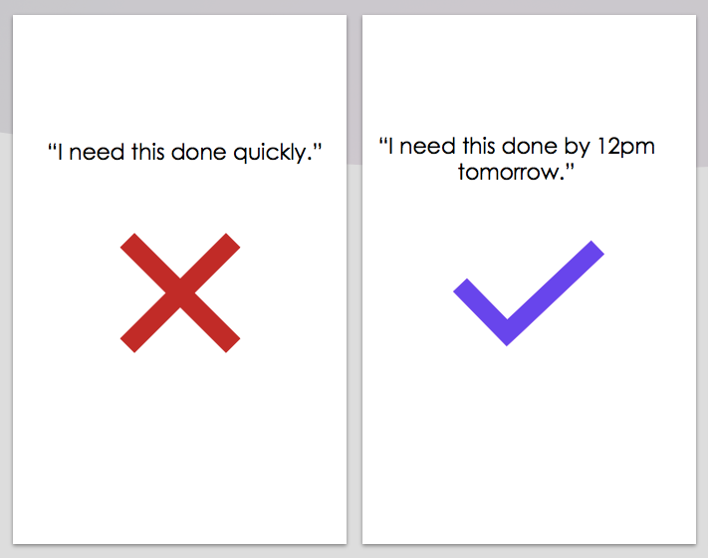
Bottom line: Get to the point! It sounds simple, but has a massive effect.
This goes for managers and remote workers. Try really hard to convey everything you need to say in one email.
Here’s what Process.st gave as an example of BAD messaging between manager and remote workers…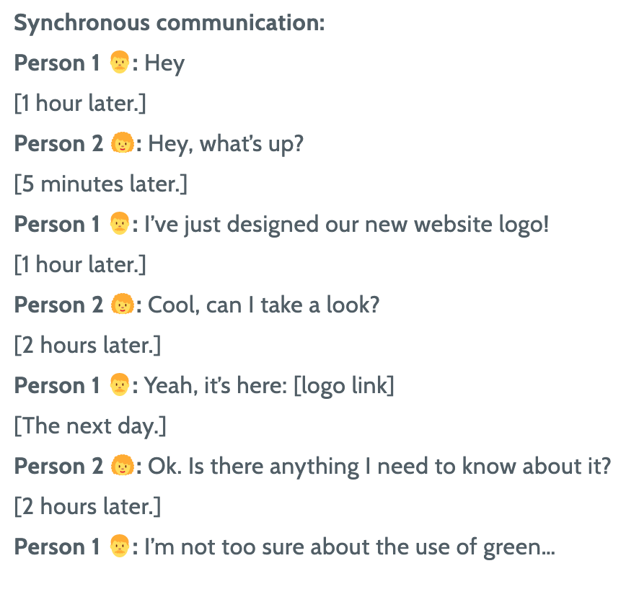
…versus GREAT messaging:
See what I mean?
Measuring Your Team’s KPIs
Tag: Management
Difficulty: Medium
It’s important to measure your remote team’s KPIs. Depending on the type of work your team does, this could involve metrics like:
- For development teams: the overall code coverage.
- For a writing team: number of valuable blog posts written.
- For a street marketing team: number of flyers and total number of photos uploaded.
KPIs shouldn’t have “number of hours worked.” This is generally not an accurate indicator of high performance.
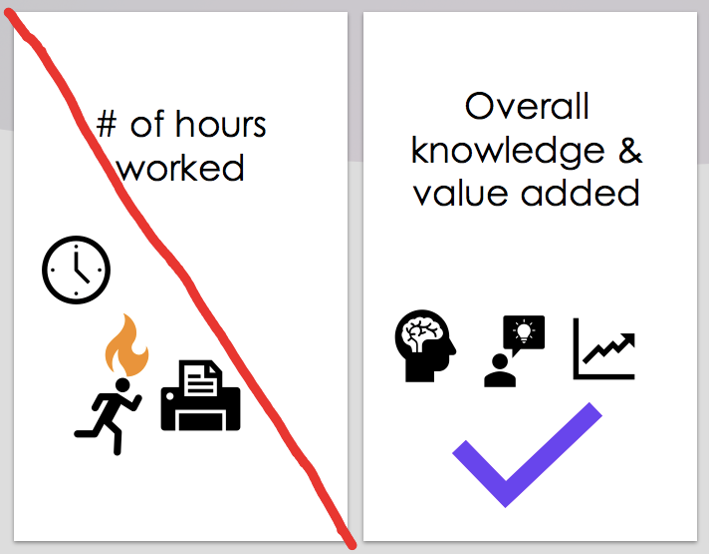
It can be tough to shake this mindset. After all, hourly wages and the classic 40-hour work week have primed us to measure our work by the number of hours we punch.
But research has shown that this mindset is dead wrong. The value of employees is in the value they create through their knowledge, not number of hours spent on the clock.
In a 2010 study, two researchers interviewed 39 corporate managers. They found that these managers generally thought of the employees who spent more hours in the office to be more committed, hardworking, and dependable, regardless of how much work they got done.

After all, if your street team member can hang every flyer in the right spots in half a day, that’s better than a team member who only hangs 75% of their flyers while working the whole day.
In some cases, it makes sense to have a “leaderboard.” This creates a healthy sense of competition between different team members and can boost performance.
But the key is, it makes it more about the work actually getting done than the person who showed up early and left late.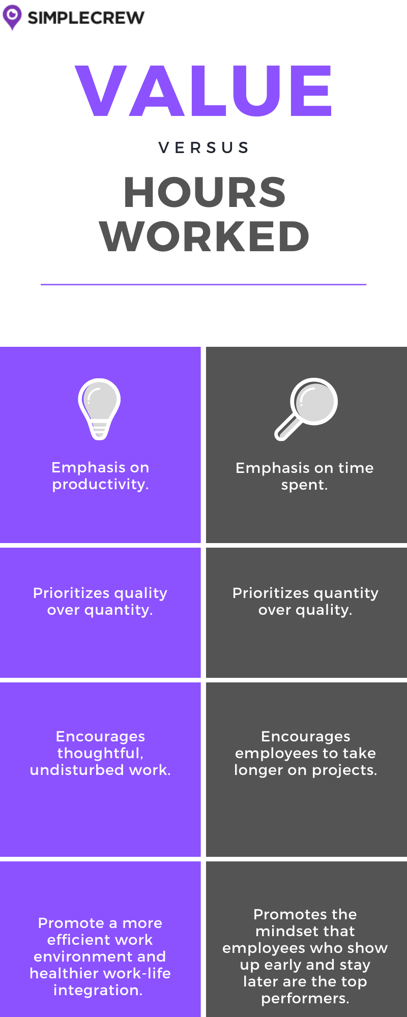
Cal Newport, best-selling author of Deep Work: Rules for Focused Success in a Distracted World, said that “three to four hours of continuous, undisturbed deep work each day is all it takes to see a transformational change in our productivity and our lives.”
Acknowledge and Reward Remote Employees’ Achievements
Tag: Employee Engagement
Difficulty: Easy
Location-independent work can sometimes foster an “us versus them” feeling. This kind of environment makes remote workers feel like their actions go unnoticed. Giving public praise signals to them that they’re pulling their weight.
Does your business have a recognition program for your remote team members? This’ll give them a chance to be rewarded for reaching certain milestones or goals.
You won’t be able to round up everyone and give an “employee of the month” plaque. But there are plenty of ways you can acknowledge remote workers contributions:
- Thank them in a public way (e.g. email blast or Slack thread) for everyone to see their accomplishment.
- Mail a handwritten thank you note to let them know how much you appreciate their work (this will go a long way).
- Give a gift card (e.g. Amazon or Starbucks)—you can also send these electronically.
- Give remote workers a bonus or pay increase. If your budget allows it, this can motivate them to continue providing outstanding work.
Unless you have a reason for remote workers to be on a different plan (e.g. they’re freelancers or contractors), try to reward them in the same way as in-office employees.
Here are a few appreciation messages you can consider sending to your top performing remote employees:
{{Thank you for everything you do. Your dedication to meet deadlines, your commitment to make every hour at work count is deeply appreciated. We love what you do and we hope you continue to give your best.}}
{{Commitment is about doing your best and not abandoning ship even in the worst crisis. You have shown us commendable commitment during this time and we want you to know that we are happy to have you with us.}}
{{Your ability to coordinate with remote team members and getting them aligned and onboard with tasks is truly commendable. We are happy to have an efficient team player with us.}}
Provide Appropriate Positive Feedback
Tag: Communication
Difficulty: Medium
Recognition programs can be great ways to provide positive feedback for remote workers. But it’s more important to do it in quieter ways on a consistent basis.
It’s clear to you when your remote employees are meeting all your expectations, but do you make it clear to them?
You should aim to provide regular feedback with each project. This could be a quick “Great work, thanks!” when they turn in a completed piece of work. This alone can strengthen the relationship.
Rob Warner, CEO of InvisiblePPC, agrees. He shared his experience with collaboration platform recognition with Bonusly:
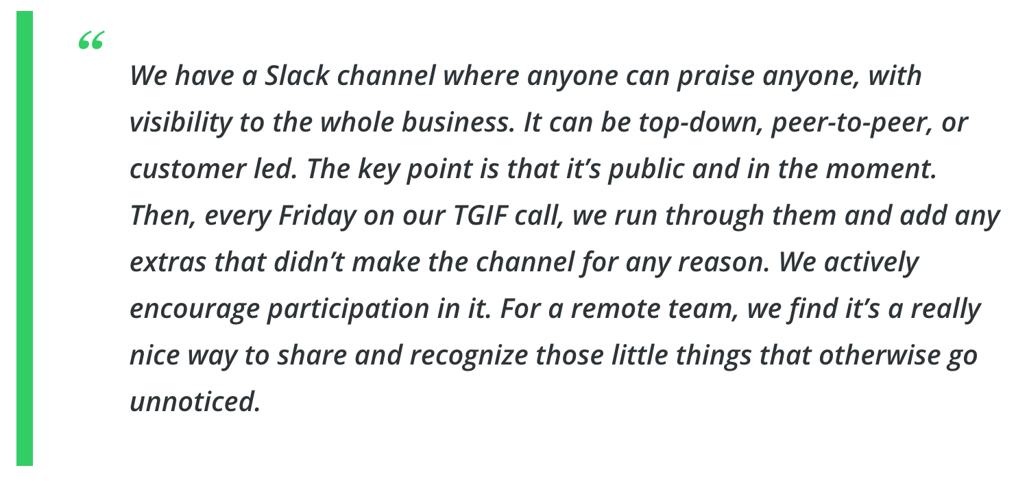
But when possible, get more specific with your feedback. Let them know you appreciate how they labeled every photo they uploaded for the campaign. That way, they can focus on repeating and building on that behavior in the future.

Here’s an example of what specific positive feedback might look like:
I was sent a report on your street team campaign performance and I see you’ve exceeded your goal by 20%! This is an impressive result and we’ve already seen a positive impact on our marketing. Great job! Would you mind sharing how you did it so quickly? It would help to keep that performance going and I’m happy to help however I can.”
Here’s a template you can follow with your own remote employees:
I just got a report of your {{what they did}}! This is a great job as we’ve already seen {{impact their performance had on business}}. Great job! Would you mind sharing how you did it?
Provide Appropriate Negative Feedback
Tag: Communication
Difficulty: Hard
It might be awkward to talk about performance issues over video call, rather than in-person. But those awkward conversations are an important part of managing remote teams.
It helps to have a system in place where you check in on a regular basis. For example, you could have a review of each remote team member once a month, followed by quarterly reviews.
From Trello’s blog:

With in-house workers, you can spot who’s having a rough time at home, who’s getting sick, or who’s struggling in their personal lives.
But with remote employees, you won’t be aware when these situations happen. For instance, if someone who generally hits every deadline suddenly starts sending in late work, you should gently check if they’re going through a tough time in their personal life.
Here’s a template email you can send a reliable remote employee you might suspect is going through something:
Hi {{First Name}},
I hope you’re well.
I’m just getting in touch because I see you’ve been late on a few recent deadlines. So far you’ve been on top of every due date, which I really appreciate.
I realize life happens, and I wanted to gently check in and see if {{your current deadline schedule or calendar}} still works for you. I’d be happy to work with you on making an adjustment.
Thanks.
{{Signature}}
Encourage Employees to Give You Feedback
Tag: Communication
Difficulty: Easy
Do you encourage your remote employees to tell you how you can make their lives easier? If not, you’re missing a huge opportunity to be a great manager and make your team run better.
Ask, and the answers might surprise you. They might want to move a Friday meeting so they can pick their kid up. Or a daily five-minute check in to go over project updates. You won’t know unless you ask.
Here are a few questions to ask your remote team members:
“Is there anything I can do for you?”
“What else could we cover today?”
“Do you have any questions for me?”
If they seem reluctant to make suggestions to you, offer to give them an anonymous survey.
Use the Right Remote Team Tools

Tag: Management
Difficulty: Easy
Project management apps have made it possible to have a productive remote team who might not ever meet face to face.
There are yet other ways you can use technology to strengthen your remote team. Here are a few options:
- Facebook Groups: if your team isn’t in constant communication, then a Facebook Group can bring everyone together for occasional updates and team announcements. This could work if you’re managing freelance writers, for example.
- Slack: this is a popular tool that many remote teams use already. The downside is, it’s limited to chat. And project management consists of so many other things.
- Email: yes, emails can help you run your team. Send out quick reminders, summaries of weekly goals and what everyone’s working on. But with email, things tend to get buried in a mountain of messages. Most managers agree how frustrating email can be.
In Conclusion
Managing remote teams can have two outcomes:
- Disaster
- Skyrocket productivity and sales
With the above remote team management tips, you can raise your chances for the latter. Keep these tips and templates in mind when you start hiring or managing a remote team.
They’re proven and time-tested to work over and over again.
“I Want to Learn More About Remote Team Management…”
If you’ve gotten to the end of this, and you still feel like you need help understanding how the right remote team management tool can help you do your job—or if you just want to say hi and ask a few questions—let us know! We’re always here and happy to help.



